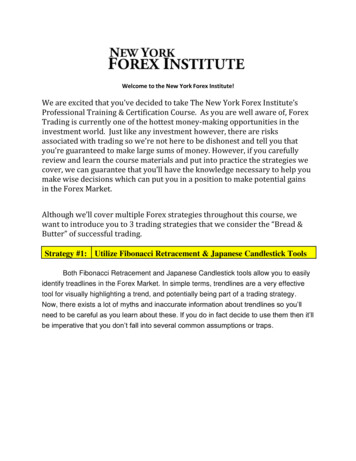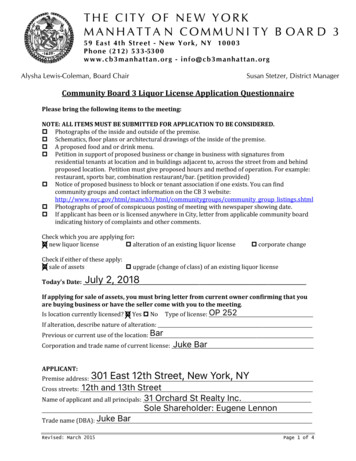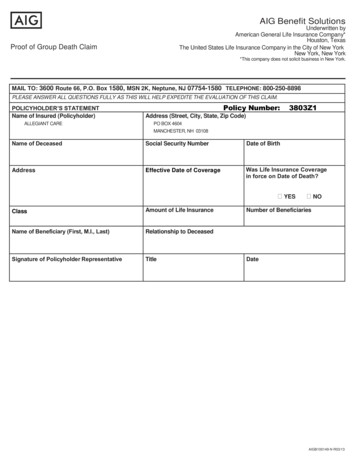
Transcription
Welcome to the New York Forex Institute!We are excited that you’ve decided to take The New York Forex Institute’sProfessional Training & Certification Course. As you are well aware of, ForexTrading is currently one of the hottest money-making opportunities in theinvestment world. Just like any investment however, there are risksassociated with trading so we’re not here to be dishonest and tell you thatyou’re guaranteed to make large sums of money. However, if you carefullyreview and learn the course materials and put into practice the strategies wecover, we can guarantee that you’ll have the knowledge necessary to help youmake wise decisions which can put you in a position to make potential gainsin the Forex Market.Although we’ll cover multiple Forex strategies throughout this course, wewant to introduce you to 3 trading strategies that we consider the “Bread &Butter” of successful trading.Strategy #1: Utilize Fibonacci Retracement & Japanese Candlestick ToolsBoth Fibonacci Retracement and Japanese Candlestick tools allow you to easilyidentify treadlines in the Forex Market. In simple terms, trendlines are a very effectivetool for visually highlighting a trend, and potentially being part of a trading strategy.Now, there exists a lot of myths and inaccurate information about trendlines so you’llneed to be careful as you learn about these. If you do in fact decide to use them then it’llbe imperative that you don’t fall into several common assumptions or traps.
It should be noted that Trendlines are also a technical analysis tool used to define andproject price trends in major markets such as stocks, forex and futures markets. In otherwords, they have the potential to alert us when a “pullback” (defined as a move againsttrend direction) is over and the trend is resuming, or when a trend is accelerating orreversing. In these instances, remember that price will be the ultimate indicator. In otherwords, price action (how the price itself is moving) must always be considered whenusing trendlines.
Now, if you’re new at Forex trading and all of this sounds intimidating, don’t panic!Fortunately, with the innovation of investment tools and analytics, reputable companieshave launched Pro Trading software that help simplify this process for you and actuallydo a lot of this work for you so you can capitalize on potential gains. When starting outinvesting in the market, we suggest utilizing both Japanese Candlesticks and FibonacciRetracements to help you with your trendlines. This will really help to streamline theprocess and you’ll actually come to realize that it’ll be easier to anticipate gains in themarket.For more information on how to spot trends and treadlines, we recommend you view thetutorials titled “Japanese Candlesticks” and “Fibonacci Retracement” in Bundle #9 of thecourse.Strategy #2: Start Trading Part-time in a “Price Action” Trading RoleAs you begin trading the Forex market, it’s important to first familiarize yourself with themarket. Obviously, this doesn’t happen overnight and will take a little while for you tobecome completely comfortable. For that reason we recommend that you begin doing itpart-time. In fact, very few people are available to trade Forex full-time due to theamount of experience and knowledge they must first attain before feeling comfortable todo so. More often than not, traders make their trades at work, lunch or night.The problem with this type of (part-time) trading is that with such a fluid market, tradingperiodically throughout a small portion of the day will create a lot of missed opportunitiesto either buy or sell. In other words, there is huge potential for a complete loss of fundsif a position is not existed before the market moves against it or a loss of opportunity tobuy at a wanted price. This is what makes part-time trading to be difficult.For that reason, as you begin as a “part-time” trader, you’ll want to do so using ‘priceaction” trading methods. Now, “price action” trading methods can be subjective in natureso to narrow it down, this is a strategy that can be used during brief but frequent tradingperiods (for example, such as 10-minutes at a time).In order to understand exactly what “price action” trading is, it can also be defined asanalyzing technical indicators or charts of the currency pair and then trading based on
what the chart tells you. In its most basic level, traders can analyze up bars which is abar that has a higher high or higher low than the previous bar, and look at down bars,which is a bar with a lower high or lower low than the previous. Remember that Up barssignal an uptrend while down bars signal a down trend.So what chart(s) is best to use in analyzing these movements? We highly recommendthe candlestick and price bar charts as you get use to this since they’re rather simple.Other price action indicators may be inside or outside bars.However, choosing the chart time frame that best meets your schedule availability iskey to success with this. Also be cognizant of the random movement of prices (highsand lows) or swings. You can measure these using tests of resistance and consolidationwhich are other examples of price action.To learn more about tests of resistance and consolidation please view the tutorial inWeek/Bundle #9 titled “Support & Resistance.”
Strategy #3: Always Use a Stop Loss with a Fixed Percentage of your Account SizeAs you begin trading the Forex market and attempt to develop confidence in yourabilities, it’s important to not put all of your eggs in one basket and risk everything in onetrade. In order to fight against any temptation that you may have of doing this, werecommend that you always use a stop loss with a fixed percentage of your accountsize. For example, when you first start out, a good fixed percentage to use would be1%. What this essentially means is that you’d have to lose 100 trades in a row to wipeout the entire balance in your account. Chances are this will not happen. At worse, youmight get into some bad trades and lose 15 in a row but when you utilize a stop loss toa small fixed percentage of your account size then this strategy will allow you somepeace of mind knowing that you will soon get going in the right direction.To learn more about a Stop Loss, review the tutorials entitled “Limit Order,” “StopOrder,” “Stop Limit” and “TTO (Stop & Take Profit)” found in Bundle/Week #10.
What do you want to get out of this course? Just like any new skill we learn, we must put inthe time and effort to improve it. In other words, you’ll only get out of this course what youput into it. Therefore, in order to help you stay on track and focused throughout the course,we recommend that you first write down 3 main goals that you want to achieve as a resultof taking this certification course. In addition, you’ll want to write down a plan of actionand explain/describe how you’ll accomplish your specific goals. Now, what are they?1.)How will you accomplish your first goal?2.)How will you accomplish your second goal?
3.)How will you accomplish your third goal?
Welcome to the New York Forex Institute! We are excited that you’ve decided to take The New York Forex Institute’s Professional Training & Certification Course. As you are well aware of, Forex Trading is currently one of the hottest money-making opportunities in the investment










